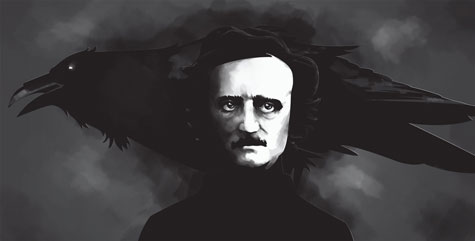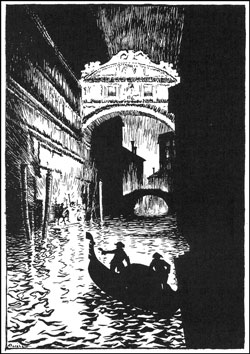
It was Edgar Allan Poe's birthday this week (he would have turned 207 on January 19th), and the man who gave us so much with his writing managed to be so selfless as to give us a birthday gift. Though not actually a supernatural gift from the grave, one of Poe's earliest short stories, “The Assignation,” had been misinterpreted for years and may actually be the world's first murder mystery.
The scene is Venice, the fabulous palazzo of the world-renowned “Genius of Romance.”
Dawn.
The night before, at the Ducal Palace, a baby—child of the aging Doge and his dazzling young wife—fell into the canal. Just when hope for the boy seemed lost, our hero emerged from nowhere, dove into the canal, brought up the child, and delivered him safe to his blushing, scantily clad mother. As the hero departed, she whispered to him, saying, “One hour after sunrise we shall meet.”
Now, just after sunrise in his palazzo, the hero is conversing with the acquaintance who had ferried him home from the palace: the narrator of the tale. Suddenly a servant from the palace bursts in and cries, “My mistress! – my mistress! – Poisoned! – poisoned!”
The narrator rushes to relay the news to the hero, only to discover that he, too, has been poisoned. “A consciousness of the entire and terrible truth,” says the narrator, “flashed suddenly over my soul.” And there the story ends, leaving us to shout at the page, “What truth?! What happened?!”
 The “The Assignation,” one of Edgar A. Poe’s earliest stories is, in fact, the first true murder mystery ever written—though it was not recognized as a mystery at all for some 170 years.
The “The Assignation,” one of Edgar A. Poe’s earliest stories is, in fact, the first true murder mystery ever written—though it was not recognized as a mystery at all for some 170 years.
The accepted theory was that the story is a romance, in which the two lovers killed themselves in a suicide pact. Separated in life, they would finally be united in death. But that reading is dissatisfying. There is little in the story to support it, and it leaves you with many things that don’t make sense. But, nobody offered an alternative explanation, and the story was largely ignored.
In 1963, a scholar named Richard P. Benton produced a key. The tale, he said, is a riff on the real-life story of Lord Byron and the beautiful Italian countess who ran off with him, as recounted in Thomas Moore’s best-selling biography of Byron. Poe’s story should thus be viewed as a hoax, pretending to be a romantic tale but actually a parody of one.
Benton was clearly onto something, but the tale still didn’t gel. If it was a parody, why wasn’t it funny? Why was it so confusing?
The reason is that the true object of Poe’s parody is not Byron’s affair or tales of romance, but specifically Moore’s biography. In that book, two things stand out. One is how totally bitchy Moore is. His constant tone is smarmy, like a person who pretends to be complimenting you, but beneath the compliment is a veiled insult. At once the key turns, unlocking the story. Poe’s narrator is like Moore—a fraud whose account is twisted by malicious envy.
Re-reading the man’s account the way we would read the words of a suspect in a murder mystery, we suddenly see it all. The parts of the story that previously did not add up now fall breathtakingly into place. That explains his cockamamie story about how he got to the palace; his breathless description of the Marchesa in her gauzy nightgown; why the Doge seemed unconcerned about the drowning child; and why the efforts of the rescuers were so feeble. These are all clues, all pointing to the same conclusion.
Best of all is the mysterious poem that the narrator says he found in a book in the hero’s palazzo. The narrator makes a great puzzle over who may have written it and the reader is left wondering what this has to do with anything else in the story. The answer lies in the second important feature of Moore’s biography: a humiliating blunder he made in claiming to have discovered a youthful poem by Byron never before published. In the second edition, he admitted the poem had been written and published by someone else.
Ah-ha! Now we know what this is all about. Poe’s narrator is not puzzled by the poem: he is trying to pass it off as the hero’s when it was really written by someone else. Poe has turned Moore’s famous blunder into the smoking gun that reveals the murderer. Now that is funny.
“The Assignation” was Poe’s first hidden murder mystery, but not his last. He pulled the same sort of tricks in some of his most famous tales. Readers just haven’t caught up with him yet.
Poe was born January 19, 1809. Here you can find my article on “The Assignation.”
Susan Amper, author of How to Write About Edgar Allan Poe, still mourns the loss of her Nancy Drew collection.

Don’t you mean 207? He was born in 1809.
The story was published in 1834, and I published an article in Poe Studies/Dark Romanticism: “The Biographer as Assassin: The Hidden Murders in ‘The Assignation’” in 2002. So I’m counting from 2002, and my 170 year approximation is more accurately 168 years.
A birthday present from Edgar A. Poe is a great gift for anyone who loves horror stories.
Oh thank you, finally a juicy article on this story. Im absolutely going to read that article. Thank you!